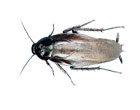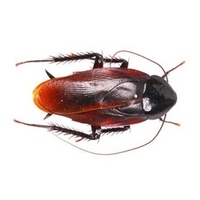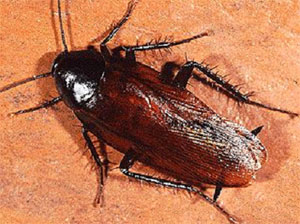
 How to Identify Smoky Brown Cockroaches
How to Identify Smoky Brown Cockroaches
Is the roach as large as your thumb and dark mahogany, almost black? If so, this is a smoky brown cockroach.
It is very important to know which species of cockroach you have encountered since their habits and food preferences vary greatly.
Roaches (cockroaches) are among the most important pests in Raleigh, Charlotte, and Wilmington, residentially and commercially.
Their mere presence is a nuisance and they can be carriers of many common diseases.
Where do Smoky Brown Cockroaches Come From?
- You are really living in their (the smoky brown cockroach’s) neighborhood.
- The smoky brown roach lives in decaying organic material (mulch areas), oak trees habitat (outside), etc.
- These pests are nocturnal which means they are active at night. During the night, they forage, crawl into weep holes, on buildings or up the outsides of the home or structure and get into the gutters and then find cracks in the attic areas.
- They can also enter the home under loose-fitting outside doors. Smoky brown cockroaches are good flyers and can work their way down into the home where they like to live. In particular, they like flat roof areas and chimneys – this is how they enter structures.
- During the day, they can be found in leaf litter and dark protected areas around the structure.
 Where do Customers See Smoky Brown Roaches?
Where do Customers See Smoky Brown Roaches?
They can be seen in upper kitchen cabinets usually where the stove exhaust fan goes through the cabinet and into the attic and in all lower cabinets in the kitchen as well as bathroom cabinets.
These roaches are also seen in den areas or rooms that are directly beside the chimney, even upstairs bedrooms. Smoky brown roaches primarily live in attics and chimneys. Young nymphs have white tips on their antenna. The adults can be very frightening since they are big insects and fast.
Smoky brown cockroaches require frequent access to food and water, otherwise they dry out very quickly. When they enter a home, they are primarily searching for a water source.
How do Smoky Brown Cockroaches Multiply?
The female, when inside the home, lays a dark-brown to black egg capsule every 10-15 days — up to 17 egg capsules in her lifetime. Up to 24 nymphs (baby cockroaches) can come out of that capsule.
As you can see, you can have quite a pest problem with smoky brown roaches.
Ways to reduce the conditions that harbor and attract the smoky brown roaches:
- Remove leaf clutter near structure
- Remove brush piles from structure
- Seal gaps around doors and windows
- Repair foundation cracks
- Repair moisture-damaged wood inside and outside structure
- Repair foundation vents, screens
- Clean gutters and downspouts of debris
- Clean garbage cans
- Move garbage cans 25 feet from structure
- Clean all pet food dishes and remove spilled pet food
- Repair all leaks in structure
- Seek professional assistance and a pest prevention plan
Economy Exterminators’ Pest Control Solutions program uses the 4-step approach to solve your smoky brown roach pest problem:
- Our 1st step is the inspection of the property by a Raleigh, Charlotte or Wilmington customer service representative. It is very important to know the species involved and the severity of the pest problem.
- The 2nd step would be the initial treatment by a customer service representative of all areas that the inspection revealed as critical areas. Economy Exterminators uses the newest and most effective materials to solve this pest problem quickly for you. Usual critical areas would be the kitchen cabinets, bathroom cabinets, attic areas, storage rooms, chimneys, and garages. Exclusive proprietary methods and techniques are used to provide safe, effective pest elimination and prevention.
- The 3rd step is a 37-point inspection of your property to identify areas on your property that allow easy access for the smoky brown roach to your property by either direct access (cracks in the foundation) or by eliminating harborages or food sources that would be attractive to this roach.
- The 4th step is an ongoing maintenance program for the next generation of roach. The next generation comes from the egg capsules which are placed or glued by the female in protected areas. Preventative maintenance outside by chemical and non-chemical means is what is usually required to prevent the smoky brown roach from gaining access to the inside of the structure.

 How to Identify Smoky Brown Cockroaches
How to Identify Smoky Brown Cockroaches Where do Customers See Smoky Brown Roaches?
Where do Customers See Smoky Brown Roaches?


